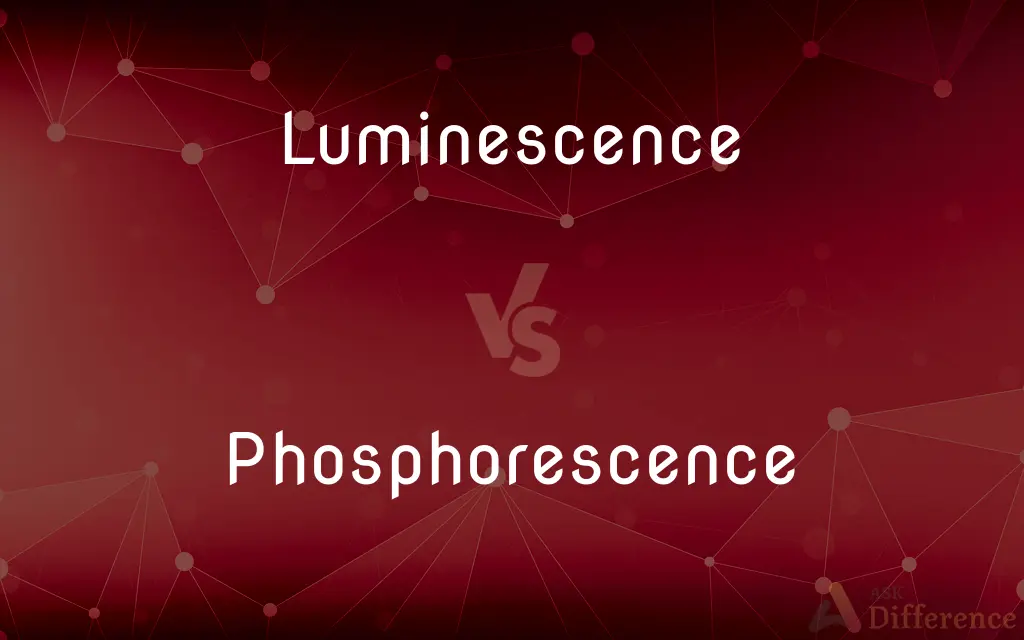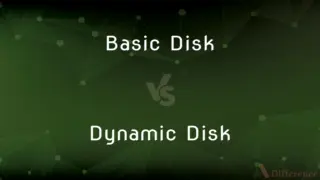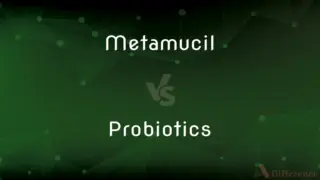Luminescence vs. Phosphorescence — What's the Difference?
By Urooj Arif & Maham Liaqat — Published on March 6, 2024
Luminescence is the emission of light by a substance not caused by heat, while phosphorescence is a type of luminescence that lasts longer after the excitation source is removed.

Difference Between Luminescence and Phosphorescence
Table of Contents
ADVERTISEMENT
Key Differences
Luminescence encompasses a broad range of phenomena where materials emit light without being heated. This can occur through various processes, such as chemical reactions, electrical energy, or physical stress. Phosphorescence is a specific type of luminescence characterized by its prolonged afterglow once the source of excitation is removed. This extended emission distinguishes phosphorescence from other forms of luminescence, such as fluorescence, which ceases almost immediately after the excitation source is no longer present.
The key difference between luminescence and phosphorescence lies in their persistence and the mechanisms behind their light emission. In phosphorescence, electrons absorb energy and jump to a higher energy state. When they return to their ground state, they emit light over a longer period due to a process called "intersystem crossing," where the electrons transition through different spin states. This process delays the release of energy as light, resulting in the characteristic glow that continues for some time in the dark.
Luminescence is observed in various contexts, from biological organisms producing bioluminescence to technological applications like LED lights and glow-in-the-dark materials. Phosphorescence, specifically, is utilized in safety signs, watch dials, and emergency exit markings, where its persistent glow is advantageous in low-light or dark conditions.
The study and application of luminescent materials, including phosphorescent substances, play a crucial role in developing new technologies for lighting, displays, and biological imaging. By understanding the principles behind luminescence and phosphorescence, scientists and engineers can design materials with desired properties for specific applications, pushing the boundaries of what's possible with light-emitting materials.
Comparison Chart
Definition
Emission of light without heat
Luminescence with prolonged afterglow
ADVERTISEMENT
Duration
Can be instantaneous or prolonged
Characteristically long-lasting
Mechanism
Various processes (chemical, electrical)
Intersystem crossing to different spin states
Applications
LEDs, bioluminescence, glow sticks
Safety signs, watch dials, emergency exits
Light Persistence
Depends on the specific type
Persists after the excitation source is removed
Compare with Definitions
Luminescence
Light emission not caused by heat.
The glow of fireflies is a form of bioluminescence.
Phosphorescence
Luminescence that persists after the stimulus is removed.
The glow from phosphorescent paint used in watch dials.
Luminescence
Used in various technologies.
OLED displays utilize electroluminescence.
Phosphorescence
Involves a delayed return of electrons to their ground state.
Phosphorescent materials in emergency exit signs.
Luminescence
Can occur through chemical reactions.
Glow sticks emit light through chemiluminescence.
Phosphorescence
Characterized by intersystem crossing.
Phosphorescent materials absorb UV light and slowly release it as visible light.
Luminescence
Can be instantaneous or last for some time.
Fluorescence in minerals stops quickly after removal from UV light.
Phosphorescence
Exhibits a prolonged afterglow.
Glow-in-the-dark stickers rely on phosphorescence.
Luminescence
Observed in nature and synthetic materials.
Certain fungi exhibit natural luminescence.
Phosphorescence
Used for safety and decorative applications.
Safety markings that need to be visible in the dark.
Luminescence
The emission of light that does not derive energy from the temperature of the emitting body, as in phosphorescence, fluorescence, and bioluminescence. Luminescence is caused by chemical, biochemical, or crystallographic changes, the motions of subatomic particles, or radiation-induced excitation of an atomic system.
Phosphorescence
Persistent emission of light following exposure to and removal of incident radiation.
Luminescence
(physics) Any emission of light that cannot be attributed merely to the temperature of the emitting body.
Phosphorescence
Emission of light without appreciable heat, as from chemiluminescence of phosphorus or bioluminescence of living organisms.
Luminescence
Any emission of light not ascribable directly to incandescence, and therefore occurring at low temperatures, as in phosphorescence and fluorescence or other luminous radiation resulting from vital processes, chemical action, friction, solution, or the influence of light or of ultraviolet or cathode rays, etc.
Phosphorescence
The emission of light without any perceptible heat; the quality of being phosphorescent.
Luminescence
Light not due to incandescence; occurs at low temperatures
Phosphorescence
The quality or state of being phosphorescent; or the act of phosphorescing.
Common Curiosities
Why do phosphorescent materials glow in the dark?
They store energy from an external light source and slowly release it over time, creating a glow that persists in the dark.
What causes luminescence?
Luminescence is caused by various processes, including chemical reactions, electrical energy, or physical stress, where materials emit light without being heated.
Can all luminescent materials phosphoresce?
No, only specific materials with the appropriate electronic structure can exhibit phosphorescence.
Are luminescent materials safe?
Most luminescent materials, including phosphorescent ones, are safe for general use, though the safety of specific materials depends on their chemical composition and application.
Can luminescence be used for energy production?
While luminescence itself does not produce energy, it is a key principle in light-emitting devices that can convert electrical energy into light efficiently.
Where is luminescence used in everyday life?
Luminescence is used in LEDs, display screens, glow sticks, and biological imaging.
How are new phosphorescent materials developed?
Scientists create new phosphorescent materials by manipulating the electronic structures of substances to control their light-emitting properties, often through chemical synthesis and engineering.
How is phosphorescence different from fluorescence?
Phosphorescence involves a prolonged emission of light due to intersystem crossing, while fluorescence ceases almost immediately after the excitation source is removed.
How long can phosphorescent materials glow?
The glow can last from several minutes to several hours, depending on the material's composition and the intensity of the initial excitation.
Is the glow from the ocean bioluminescence or phosphorescence?
The glow is typically bioluminescence, produced by marine organisms, and not phosphorescence.
Share Your Discovery

Previous Comparison
Basic Disk vs. Dynamic Disk
Next Comparison
Metamucil vs. ProbioticsAuthor Spotlight
Written by
Urooj ArifUrooj is a skilled content writer at Ask Difference, known for her exceptional ability to simplify complex topics into engaging and informative content. With a passion for research and a flair for clear, concise writing, she consistently delivers articles that resonate with our diverse audience.
Co-written by
Maham Liaqat












































